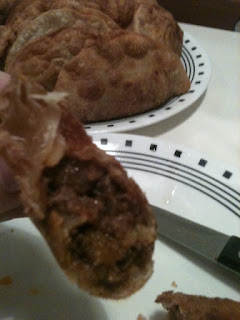 I'm back! It's been far too long since I've made my last post. It's been a crazy, busy summer and I am excited by the arrival of autumn, my favorite season. Though I've done my fair share of cooking while I've been away from the blog, I unfortunately haven't photographed much of what I've made. My next few updates, however, will feature some of the stuff I have managed to photograph.
I'm back! It's been far too long since I've made my last post. It's been a crazy, busy summer and I am excited by the arrival of autumn, my favorite season. Though I've done my fair share of cooking while I've been away from the blog, I unfortunately haven't photographed much of what I've made. My next few updates, however, will feature some of the stuff I have managed to photograph.Believe it or not, the dish I'm featuring in this post is the product of a "use whatever is in the fridge/pantry" challenge of sorts. It was the night before hurricane Irene was to hit New York, I was home alone, and the MTA subway and buses weren't operating. This meant that if something wasn't in walking distance, I basically couldn't go unless I wanted to pay cab fare both ways. Around 9:00 P.M., I was already bored and wanted to eat. Because I didn't want to open the hurricane supplies - read: peanut butter, bread, pop tarts, Trader Joe's non-perishable curries, etc. - I decided that it would be a good idea to try to use some things that would spoil if we were to lose power later that night. Since I had some thick-cut, boneless pork chops, a small onion - and some sage growing outside of my window - this challenge wasn't a very difficult one. I really shouldn't even be calling it a challenge, at all.
Ingredients:
Boneless pork chops, preferably thick-cut
1 small onion, chopped
3 tablespoons maple syrup
2 tablespoons apple cider vinegar (any kind of vinegar would be fine here)
Salt and pepper
1/2-cup red wine
2 tablespoons butter
Fresh sage, to taste
Procedure:
(1) Sautee the onions in 1 tablespoon of melted butter over medium heat, for about 10-15 minutes. After onions have begun to soften, be sure to stir frequently so that they don't burn. Note that you won't need to do a standard low-heat, 45-minute-plus caramelization here because the addition of the wine, vinegar and maple syrup will help to soften the onions and accelerate the process.
(2) Add the wine, vinegar and maple syrup and turn down the heat to low-medium.
(3) Salt both sides of the pork chops. Pepper liberally. These pork chops need black pepper's bite to stand up to the somewhat sweet sauce that will go over them.
(4) Over medium-high heat, sear the pork chops for a few minutes. Flip and allow to sear for a few more minutes on their reverse side.
(5) When pork is cooked, add each chop to the sauce - after adding the remaining tablespoon of butter - and coat thoroughly.
(6) Remove to a serving platter, spoon sauce over the top of each chop and finish with a liberal sprinkle of fresh sage in chiffonade.






